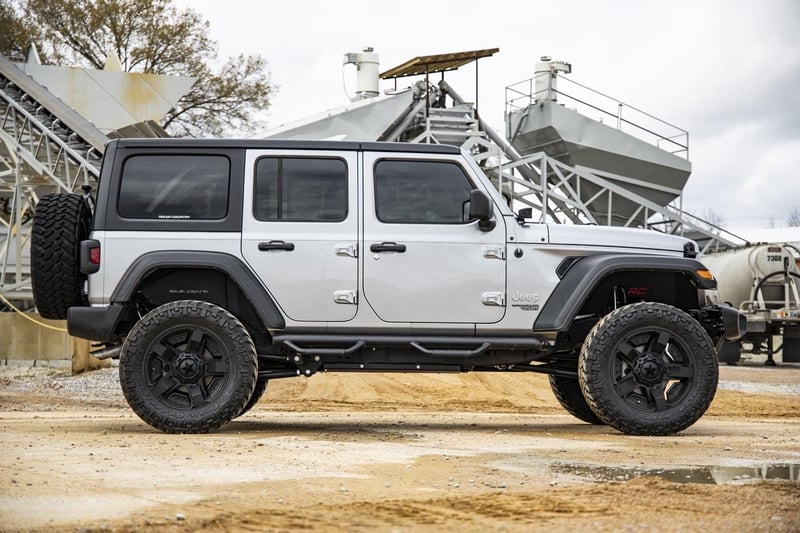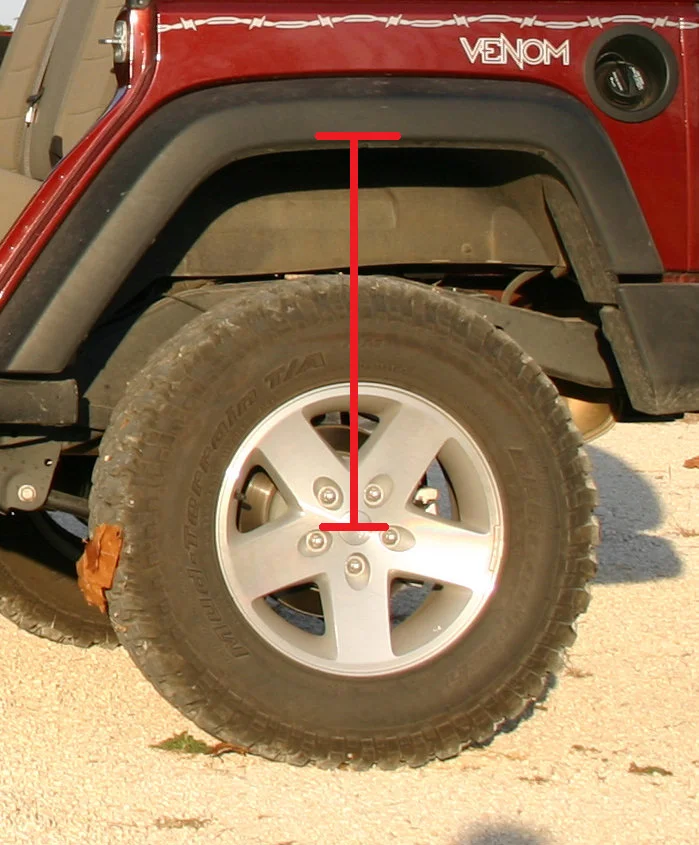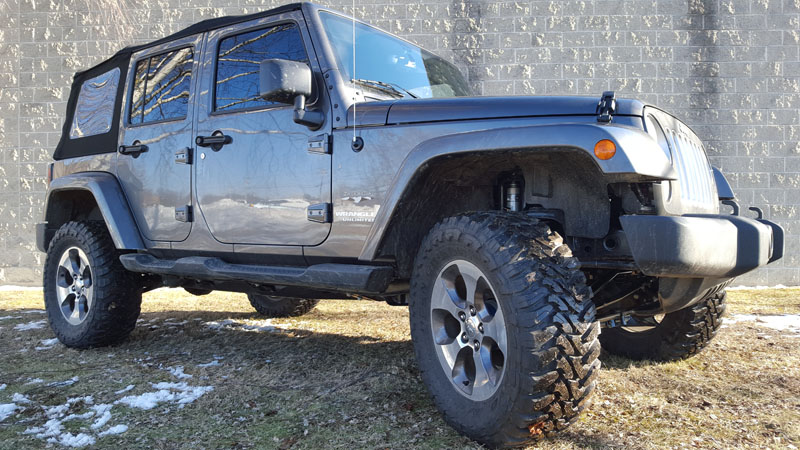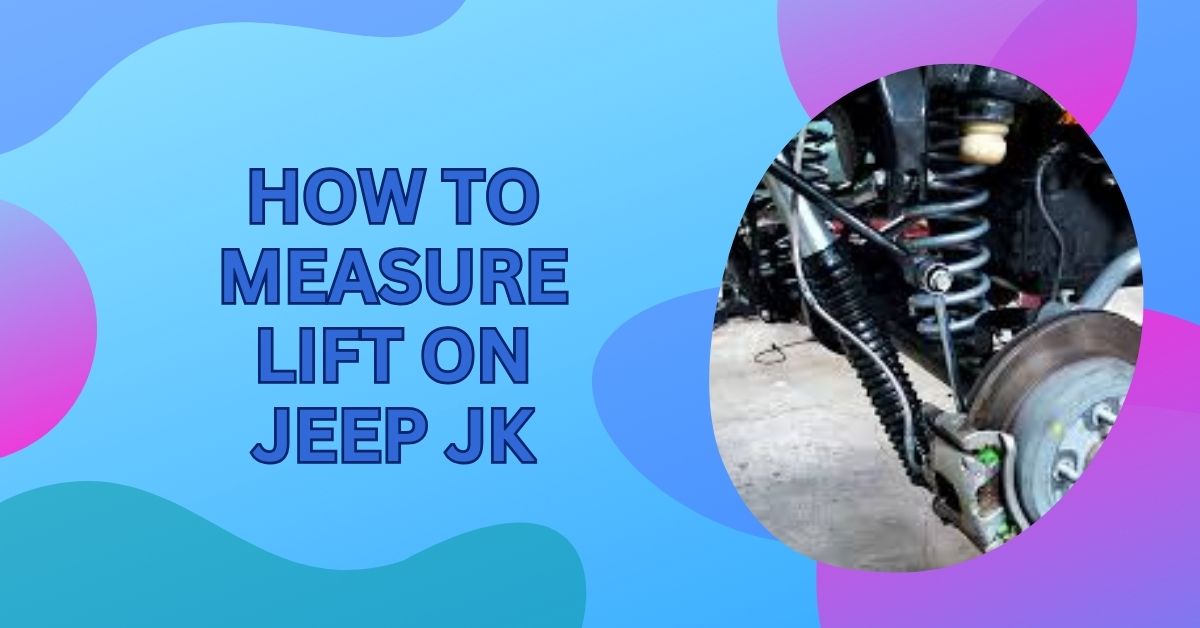Lifting your Jeep, JK can improve off-road performance, enhance appearance, and provide space for larger tires.
To measure lift on a Jeep JK, measure the distance from the ground to the bottom. Subtract the stock height (usually 34 inches) from your current measurement to determine the lift size. This helps identify how much lift your Jeep has.
This article will guide you through various methods and tools for measuring lift height on different Jeep models, including the JK, TJ, and others. We’ll also cover the importance of lift kits, suspension changes, and how to keep your Jeep running smoothly.
What Is Lift Kit On A Jeep?
A lift kit raises your Jeep’s height by modifying the suspension or body. This helps improve ground clearance, allows for bigger tires, and enhances your Jeep’s off-road capabilities while giving it a rugged, standout look.
Different Types Of Lift Kits
There are two main types: suspension lifts, which adjust the suspension for height and articulation, and body lifts, which raise the Jeep’s body from the frame. Suspension lifts offer more performance, while body lifts are more budget-friendly for moderate height.
Why Lift A Jeep?
Lifting a Jeep improves off-road performance, allows you to fit bigger tires, and increases clearance to navigate rocks and trails. Plus, it gives the Jeep a bold appearance that stands out on and off the road.
Fitment For Larger Tyres
A lift kit provides the clearance for larger tires, ensuring they don’t rub against the fenders. Bigger tires offer better traction, durability, and off-road capability, making them a perfect match for lifted Jeeps.
Read More: Do Jeeps Need Snow Chains – Tips For Safe Winter Driving!
Increased Ground Clearance
Ground clearance is the height of your Jeep from the ground. A lift kit raises it, helping you avoid rocks, mud, and other obstacles when off-roading. It also protects the Jeep’s underside from damage during rough adventures.
Cosmetic Appeal
A lifted Jeep looks tougher and stands out. It gives your ride a bold, rugged appearance that Jeep lovers admire. Plus, with larger tires and a taller stance, it’s a head-turner on any road or trail.
Levelling Kits And Body Lifts

1. Levelling Kits
A leveling kit raises the front of your Jeep to match the back, fixing the factory rake (nose-down stance). It’s affordable, easy to install, and great for improving your Jeep’s balance and look.
2. Body Lifts
Body lifts raise the Jeep’s body from its frame, adding a couple extra inches without changing the suspension. They’re ideal for fitting bigger tires and enhancing your Jeep’s appearance, especially if you’re on a budget.
Suspension Lifts
A suspension lift raises your Jeep’s height by upgrading its springs, shocks, and suspension system. It improves ground clearance and gives better off-road performance, making tackling tough trails easier and allowing larger tires to fit.
1. Coil Lifts
A coil lift replaces or modifies the Jeep’s coil springs, adding height and improving ride quality. It’s a great choice for moderate lifts, offering better flexibility and comfort on bumpy roads or uneven off-road trails.
Differences Between Long And Short Arm Kits
1. Arm Length:
- Short Arm Kit: Uses shorter control arms, keeping the suspension close to the stock length.
- Long Arm Kit: Features extended control arms, increasing suspension reach and articulation.
2. Lift Range:
- Short Arm Kit: Ideal for lifts up to 4 inches.
- Long Arm Kit: Best suited for lifts of 4 inches or more.
3. Ride Quality:
- Short Arm Kit: Stiffer ride, especially noticeable on bumpy roads.
- Long Arm Kit: Provides a smoother, more comfortable ride.
4. Off-Road Capability:
- Short Arm Kit: Suitable for light to moderate off-roading.
- Long Arm Kit: Superior performance for extreme off-road terrains.
5. Suspension Stress:
- Short Arm Kit: Puts more strain on suspension components at higher lifts.
- Long Arm Kit: Reduces stress on suspension due to optimized angles.
6. Installation Complexity:
- Short Arm Kit: Easier and quicker to install, often requiring fewer modifications.
- Long Arm Kit: More complex, often needing frame modifications and professional installation.
7. Cost:
- Short Arm Kit: More affordable, making it a budget-friendly option.
- Long Arm Kit: Higher cost due to additional components and labor.
8. Ground Clearance:
- Short Arm Kit: Provides less ground clearance compared to long arms.
- Long Arm Kit: Improves ground clearance by repositioning control arms.
9. Maintenance:
- Short Arm Kit: Easier to maintain with fewer parts to inspect.
- Long Arm Kit: Requires more frequent maintenance due to increased complexity.
Must Read: Jeep 3.8 Oil Type – The Ultimate Guide to Engine Maintenance
10. Ideal Use Case:
- Short Arm Kit: Great for daily drivers and mild off-road enthusiasts.
- Long Arm Kit: Perfect for hardcore off-roaders and those seeking high lifts.
How To Measure A Jeep Lift Height

To measure lift height, compare the distance between the fender and the ground on a stock Jeep to your lifted Jeep. Subtract the stock height from the current measurement to achieve the actual lift.
1. TJ Wrangler Lift Measurement
For a TJ Wrangler, measure from the center of the wheel to the bottom of the fender. Compare this to the stock height (typically 19” front, 20” rear) to calculate the lift height.
2. JK Wrangler Lift Measurement
For a JK Wrangler, measure from the ground to the bottom of the fender. A stock JK usually measures about 34 inches. Subtract this from your current height to determine the lift added.
How To Measure Lift On Jeep JK 2016
Park your 2016 JK on level ground. Measure from the bottom of the fender to the ground, front and rear. Subtract the stock height (around 34”) to find your lift height.
How To Measure Lift On Jeep JK 2015
For a 2015 JK, follow the same process. Use a tape measure to record the distance from the ground to the fender and subtract the stock height (around 34”). This gives the actual lift measurement.
How To Measure Lift On Jeep JK 2021
To measure the lift on a 2021 Jeep JK, park it on a flat surface. Measure the front and rear from the ground to the bottom of the fender. Compare this to the stock height (about 34 inches) to determine your lift size.
How To Measure Lift On Jeep JK 2009
For a 2009 Jeep JK, use a tape measure to check the distance between the ground and the bottom of the fender flares. Subtract the factory height (around 34 inches) to calculate the lift height achieved.
How To Measure Lift On Jeep JK 2007
To measure lift on a 2007 Jeep JK, park on level ground. Measure the distance from the bottom of the fender to the ground. Subtract the stock height (about 34 inches) to find your Jeep’s lift measurement.
How To Tell What Size Lift Is On My Jeep TJ
To check your Jeep TJ’s lift size, measure from the center of the wheel to the bottom of the fender flare. Then, the measured height was compared to the stock height (around 19 inches front, 20 inches rear) to determine the added lift.
Jeep Wrangler Lift Calculator
The Jeep Wrangler Lift Calculator is a tool that helps determine the height of your Jeep’s lift based on measurements before and after modifications. It simplifies finding out how much your Jeep has been raised, especially after installing a lift kit or larger tires.
1. How It Works
- Stock Measurement: Measure the distance from the ground to the bottom of the fender flares on a Jeep or use the manufacturer’s baseline height (e.g., 34 inches for a stock JK).
- Current Measurement: Measure the same distance on your modified Jeep.
- Calculate Lift Height: Subtract the stock height from the current height to determine the lift height.
2. Formula
Lift Height = Current Fender Height − Stock Fender Height
3. Example Calculation
- Stock Height: 34 inches (JK model)
- Current Height: 38 inches
- Lift Height:
Lift Height = 38 − 34 = 4 inches
This means the Jeep has a 4-inch lift.
Jeep JK Stock Ride Height

For most models, the stock ride height of a Jeep JK is typically 34 inches from the ground to the bottom of the fender. This serves as the baseline for measuring and calculating your Jeep’s lift height after modifications.
How to Check Caster and Pinion angle on your Jeep or Truck
Use an angle finder or inclinometer to check the caster and pinion angle. Measure the angle of the axle’s pinion and the control arms. Proper angles are crucial for smooth handling and to prevent vibration in lifted vehicles.
How Do I Determine How Much Lift My Jeep Wrangler Jk Has?
Measure from the ground to the bottom of the fender flares and compare this to the stock height (34 inches). The difference is the lift amount. Alternatively, check the lift kit’s suspension components for labels or part numbers.
Also Read: Jeep Wrangler Pulls To The Right When Braking – Guidance!
FAQs
1. How Do You Measure A 4×4 Lift?
To measure a 4×4 lift, compare the fender height to the stock height and calculate the difference.
2. What Is The Acceptable Pinion Angle?
The acceptable pinion angle is typically 1-2 degrees below the driveshaft angle to prevent vibrations during driving.
3. What Is The Correct Caster Angle For A Jeep JK?
The correct caster angle for a Jeep JK is 4-6 degrees positive, ensuring proper steering and alignment.
4. Does Tyre Size Affect Pinion Angle?
Yes, tyre size changes suspension geometry, which can indirectly affect the pinion angle, requiring adjustments after installation.
5. What Is The Best Pinion Angle For Traction?
The best pinion angle for traction is typically 1-2 degrees below the driveshaft angle, ensuring better grip and power transfer.
6. What Should Front Pinion Angle Be?
For smooth performance, the front pinion angle should align closely with the driveshaft, typically at zero to two degrees positive.
7. How To Figure Out Pinion Angle?
Use an angle finder to measure the pinion and driveshaft angles. Subtract the two to determine the difference.
8. Why Regear With Bigger Tyres?
Regearing with bigger tyres helps maintain proper performance and fuel efficiency by matching the new tire size to the axle ratio.
9. What Would Happen If The Pinion Depth Is Not Measured Properly?
If the pinion depth is incorrect, it can cause gear noise, premature wear, and even gear failure over time.
10. What Is The Ideal Driveshaft Angle?
The ideal driveshaft angle is usually between 1 and 3 degrees, ensuring smooth power transfer and preventing vibrations or damage.
Conclusion
In conclusion, measuring the lift on your Jeep JK is a simple yet essential process for determining how much clearance and capability your vehicle has gained. Whether you’re using a lift kit for off-roading or cosmetic appeal, knowing your Jeep’s lift height helps you maintain optimal performance. Properly measuring and understanding your lift can also guide future upgrades and adjustments. Ensure accurate measurements to keep your Jeep running smoothly and ready for any adventure.






0 Comments